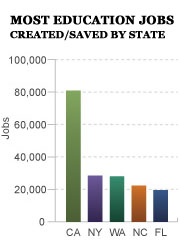 Because of the economic downturn, state revenues plunged with many state governments facing combined shortfalls of more than $33 billion for both the 2008-09 and the 2009-10 school years. In response, the Recovery Act set aside $48.6 billion for the State Fiscal Stabilization Fund, which provides grants from the Department of Education to state governments to preserve existing school jobs, create new ones, and help pay for educational reforms. The grants are available to all public elementary and secondary schools and institutions of higher learning.
Because of the economic downturn, state revenues plunged with many state governments facing combined shortfalls of more than $33 billion for both the 2008-09 and the 2009-10 school years. In response, the Recovery Act set aside $48.6 billion for the State Fiscal Stabilization Fund, which provides grants from the Department of Education to state governments to preserve existing school jobs, create new ones, and help pay for educational reforms. The grants are available to all public elementary and secondary schools and institutions of higher learning.
States began applying for Stabilization Fund money last spring, and according to the Department of Education:
- Thirty-one states designated $13.1 billion in Recovery funds to fill emergency shortfalls for the 2008-09 school year
- Forty-eight states designated $20.3 billion of the funds to fill anticipated shortfalls for the 2009-10 school year
- For K-12 education budgets during the 2008-09 school year, Recovery funds filled a 9 percent revenue shortfall in California, Indiana, Alabama and Oregon; a 12 percent shortfall in Florida, Wisconsin and South Carolina; and a 23 percent shortfall in Illinois
- Public universities in 31 states used Recovery funds to help lessen tuition increases.
Data reported by recipients also lists nearly 256,000 jobs created/saved by the State Fiscal Stabilization Fund grants. But the fund is only one of the Recovery programs overseen by the Department of Education. Collectively, recipients of money from 13 Recovery-related programs have reported creating/saving almost 400,000 jobs – mainly those of teachers, principals, administrators, instructional assistants, bus drivers, guidance counselors, librarians, school nurses, and information technology experts, according to the Department of Education.
For more information, contact your state education officials.
Read the full report:
 Department of Education Report: Summary of Programs and State-by-State Data
Department of Education Report: Summary of Programs and State-by-State Data
(PDF 1.5 MB)
Back to Featured Stories